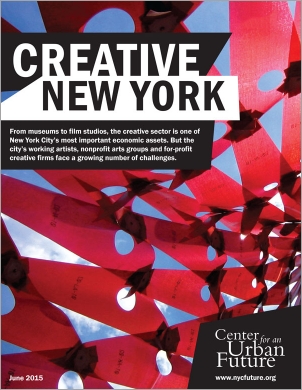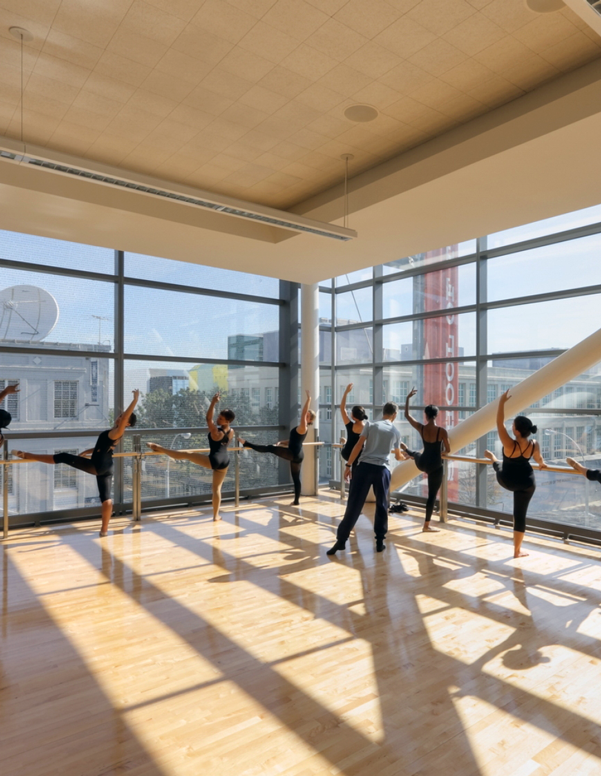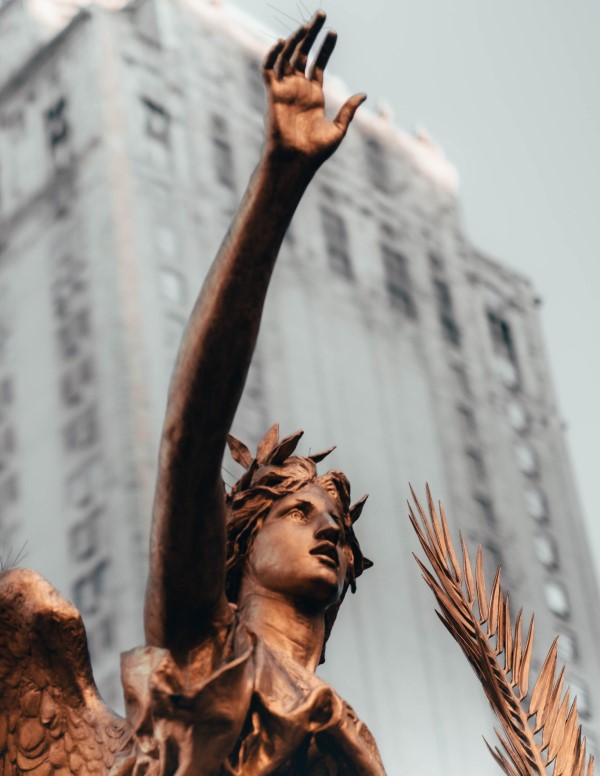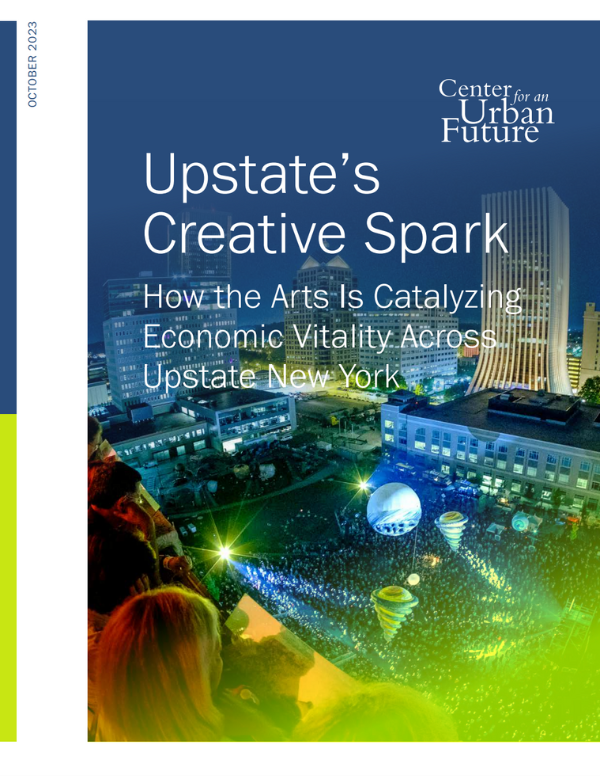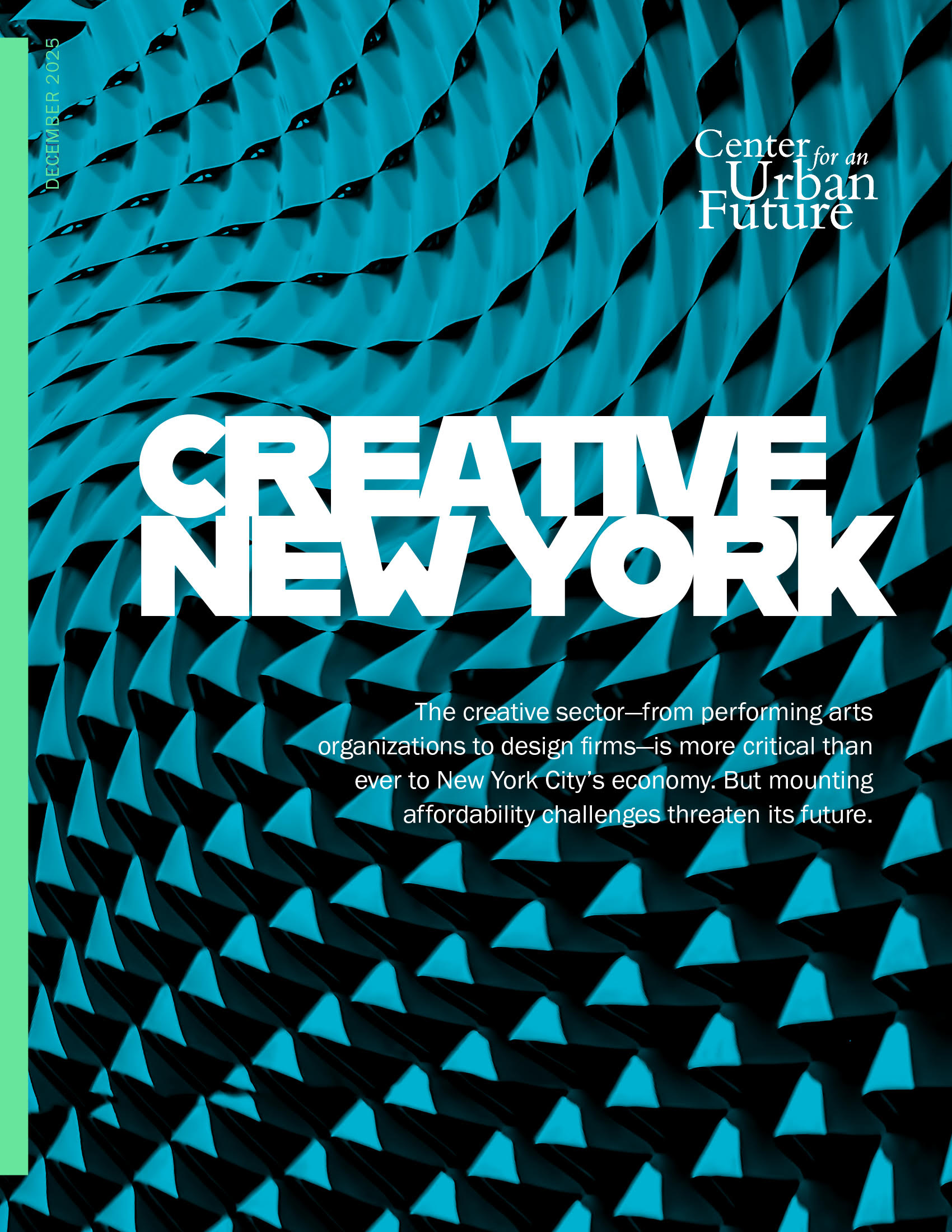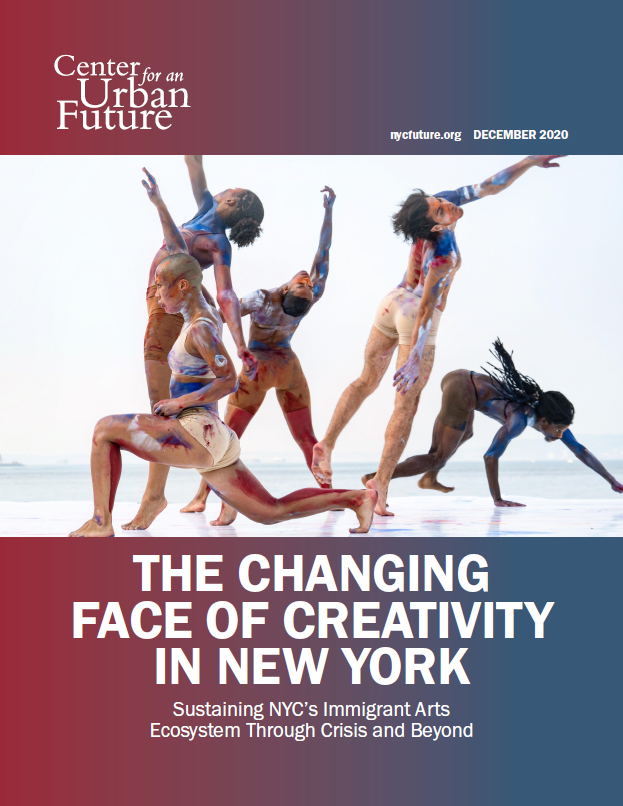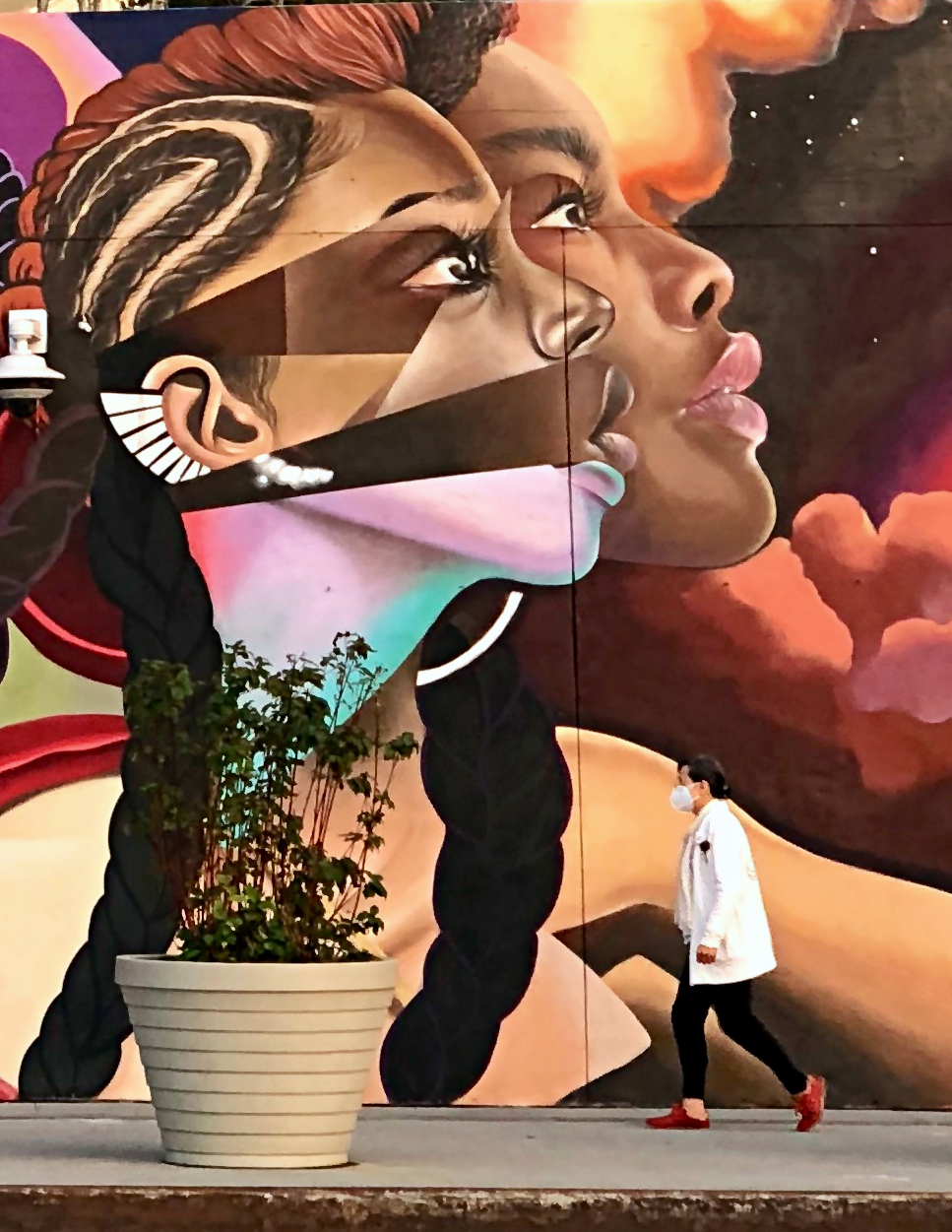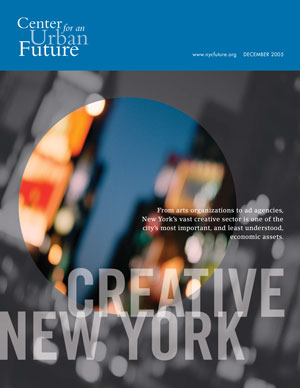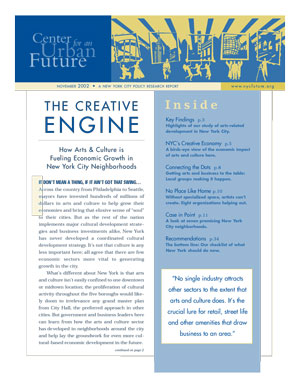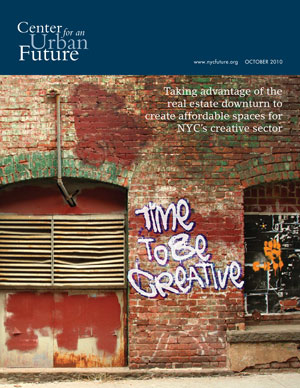The following are the recommendations from Creative New York.
Read the full report (PDF).
After an unprecedented investment in cultural capital projects and a strong emphasis on promoting tourism during the Bloomberg administration, Mayor de Blasio is taking steps to ensure that opportunities to produce and consume culture in New York are broadly shared and that working artists and creative professionals can afford to live and work here. But there is a lot more to be done. To that end, we propose more than 20 steps that the de Blasio administration can take to address and ultimately overcome the chief obstacles documented in this report. These include creating a dedicated funding stream to provide more operating and programming support for cultural organizations; investing in arts education; expanding existing efforts to create affordable housing and studio spaces for artists; leveraging artists and cultural organizations to promote community development; and better utilizing designers and other cultural businesses in the delivery of government services.
Real Estate Affordability
1. Build on successful models for providing affordable work and rehearsal spaces for artists
As rents rise in New York, many creative individuals, organizations and businesses are struggling to find suitable rehearsal, production and performance space. In recent years, the city has introduced a number of initiatives to address these affordability challenges and should look to extend them.
The Seniors Partnering with Artists Citywide (SPARC) program, for instance, is a partnership between the DCLA and Department for the Aging. Participating artists receive a stipend and access to senior center workspaces in exchange for providing arts programming for seniors. This program could be replicated at a number of other city spaces, including homeless shelters, hospitals, libraries, recreation centers and community facilities in city housing projects. Providing artists with affordable spaces while offering arts programming to underserved populations like the homeless and public housing residents as well as the youth, senior and immigrant populations that frequent libraries, would be a win-win.
Even more ambitious and timely would be a partnership between the DCLA and DOE. As evident in its recent community schools initiative, the de Blasio administration intends to use some of the city’s 1,200 school buildings as neighborhood service centers. The arts should be a beneficiary of this initiative, providing art teachers, local actors, musicians, dancers, painters and photographers as well as CUNY MFA graduates with studio and rehearsal spaces after school hours. Taking a page from the highly regarded CUNY Dance Initiative, the DCLA and the DOE should partner with local foundations to help cover custodial, security, energy and insurance expenses associated with the program.
The city could also act as a liaison between artists and religious institutions, many of which have spare capacity. Because some churches, synagogues and mosques may disapprove of the content of certain arts groups, the city could help foster appropriate partnerships. The city can also serve as a matchmaker between cultural institutions looking to secure permanent spaces. In projects like 666 Broadway and 305 Seventh Avenue nonprofits pooled resources to purchase real estate. The DCLA or EDC can work to cultivate these partnerships, helping small nonprofits establish shared office, rehearsal and performance space.
2. Provide more support for collaborative working spaces
Driven by cost pressures, quickly evolving technologies and an interdisciplinary spirit, cooperative workspaces have become increasingly popular. City, state and federal agencies should take several concrete steps to support this trend. First, the DCLA should adjust its capital strategy to focus less on new buildings and more on equipment, particularly for artist cooperatives and co-working spaces. Equipment such as cameras, laser cutters, sound systems and stage lighting carry less overhead costs than new facilities and are more targeted to the production of art. And with more and more artists pooling their resources, these equipment grants will benefit a growing share of artists. In fiscal year 2014, only $3.1 million of DCLA’s $100.5 million capital budget was devoted to equipment. Moving forward, this share could be increased and capital equipment grants could be disbursed through the peer-panel review process, as is done for programmatic grants.
Second, the DCLA, New York State Council on the Arts (NYSCA) and the National Endowment for the Arts (NEA) should resurrect the defunct NEA Workshop Grant. From the 1970s to the early 1980s, this NEA grant, designed to encourage artists to collaborate more, supported workshops and alternative spaces. One of its most prominent recipients was CoLab, an influential collective including Tom Otterness, Charlie Ahearn and Kiki Smith, which used the funding to finance its downtown Manhattan space. CoLab was the driving force behind the famous Times Square show that introduced Keith Haring and Jean-Michel Basquiat to the world. Reintroducing this grant in New York would provide needed resources to similar collaborative spaces throughout the city.
Third, residency, incubator and subsidized studio spaces should better serve artist collectives. From Governors Island and Pioneer Works to SPARC and Spaceworks, residency programs have become prevalent over the last decade. Many, however, are only available to individual artists. Moving forward, applications and spaces should be modified to accommodate collaborative projects.
Finally, as artists and creative professionals become more collaborative and venues diversify their programming, creative output has grown increasingly interdisciplinary. Many grantees, however, continue to have strict disciplinary funding buckets such as theater, dance and film. Agencies like NYSCA should consider offering more funding for multidisciplinary work and allow organizations to apply for funding under multiple categories.
3. Preserving office space and second floor retail for creative businesses and artist studios
Class B and C office buildings, so designated because they are older and have fewer amenities than Class A buildings, are rarely viewed as key engines of the city economy, but because of their lower rents, these buildings are home to a large share of the city’s architects, fashion designers, digital media companies, talent agents and other creative sector businesses. Unfortunately, the supply of Class B and C buildings has fallen over the last decade, with many converted to storage, hotels or apartment buildings. New tax exemptions or low-cost financing for tenant improvements could make it financially attractive for Class B and C owners to preserve their buildings as office spaces.
The city could also provide a boost to the creative sector by helping to unlock upper-floor retail spaces. In some of the most dynamic commercial districts in New York, a large number of second- and third-story spaces remain empty—including in downtown Jamaica, Brooklyn’s Fulton Mall and the Hub in the South Bronx. While many of these spaces have been closed off for decades and would require significant investments to bring them back up to code, they could be ideal for arts groups and artists looking for long-term affordable places to work, rehearse or perform. Moving forward, city officials should work with local development corporations and other business organizations to develop a set of carrots and sticks that could encourage landlords to rent these spaces to arts organizations, creative sector businesses, freelancers and others with significant space needs.
4. Leverage state real estate assets, including old psychiatric centers and hospitals, to address workspace affordability challenges
Like the city, New York State has significant real estate holdings that could be used by artists. The Empire State Development Corporation and Office of General Services should conduct an audit of underutilized real estate holdings to identify spaces that could be converted for studio and rehearsal use. The state maintains seven psychiatric centers in New York City, for instance, with at least one in each borough. Some have significant spare capacity that could be refashioned for use by artists.
The state already has a slew of existing programs to address affordability challenges. These should be extended. NYSCA, for instance, could broaden its successful Dance Rehearsal Space Program, which provides grants to facilities offering 1,000 hours of subsidized rehearsal time at $10 or less per hour. The program could be replicated for music and theater.
5. Develop affordable housing for artists
In February, Mayor de Blasio announced a plan to build 1,500 units of affordable housing for artists. In a city with little artist housing—by our calculation, there are only six such complexes in the city—it was a historic commitment. But clearly there is significant unmet demand. When P.S. 109 in East Harlem was redeveloped into affordable artist housings, more than 53,000 people applied for 89 affordable rental units.
Clearly, artists aren’t the only New Yorkers struggling under the weight of the city’s astronomical housing costs: teachers, firefighters and countless poor, working poor and middle class residents face the same problem. But given the outsized importance of the arts to New York’s economy, and the paucity of existing subsidized residential facilities for those in the arts, there’s a compelling case to be made that even more of the 200,000 affordable housing units the mayor plans to develop and preserve over the next ten years should be made available to low-income artists. As the Mayor begins to implement his plan, he should consider several additional initiatives that could help deliver even more affordable apartments to artists and other creative workers.
First, the administration should consider developing a new zoning category for live-work collectives in manufacturing districts. De Blasio aides have already discussed workforce housing in industrial areas while the City Council has proposed Creative Economy Districts in its report on industrial zoning. Melding these proposals, the city should consider allowing live-work spaces in M1 districts to support artist collectives. Unlike the Loft Law, which ultimately served as a wedge to open up manufacturing districts in SoHo and Williamsburg to residential housing, collectives would have to be incorporated as businesses or nonprofits and pay all members a living wage in order to qualify.
Second, as the administration continues to fine-tune its 80/20 inclusionary zoning plan, it should consider a Floor-Area-Ratio bonus for developers who provide an additional 5 percent of their space for live-work apartments for low-income artists.
6. Eliminate bureaucratic hurdles that artists face when applying for subsidized housing
The Department of Housing Preservation and Development (HPD) should work with the DCLA to make it easier for those with non-traditional incomes to apply for affordable housing. The process of applying for government-subsidized housing programs hinges on the ability to project future earnings. For those whose income is a patchwork from different sources—as is the case with many creative professionals—this task can be onerous. Providing assistance to those with unconventional income streams and simplifying the application process would help. The city could partner with the Actors Fund, which runs a series of classes on how to apply for affordable housing. And for healthcare, the city should follow Chicago’s lead and create a partnership between the DCLA and the Department of Health to assist artists in applying for Affordable Care Act benefits.
Government Funding and Support
7. Increase funding for cultural organizations by establishing new, dedicated revenue sources
Government support at the federal, state and city level has not kept pace with the growth of New York’s creative sector. The decline in public funding has adversely affected small, mid-sized and immigrant organizations that have greater difficulty attracting private funding. To maintain a healthy and diverse arts ecosystem, government should look to increase and stabilize its funding with new, dedicated funding sources.
Both the hotel tax and billboard tax are appropriate sources of dedicated revenue. Recognizing that its cultural assets help drive tourism and fill hotels, San Francisco, Houston and San Diego have earmarked a fixed portion of their hotel tax for arts funding. This helps San Francisco provide $14 per capita in total programmatic grants for the arts, compared to $3.70 per capita in New York. At the end of 2015, the New York’s 0.875 percent hotel room occupancy tax (part of an overall 5.875 percent occupancy tax here) will come up for reauthorization. The City Council should take advantage of that deadline to reauthorize that portion (approximately $80 million) to the DCLA’s Cultural Development Fund and the Cultural Institutions Group.
In Toronto, arts funding comes from revenue provided by the city’s billboard tax. Although New York does not have a specific billboard tax, the de Blasio administration has started to apply the commercial rent tax to billboards, mostly in the Times Square area. Moving forward, the city should commit a portion of its billboard tax revenue to public art installations, arts programming in public plazas and granting programs at the DCLA.
8. Target mid-sized organizations for funding and make it possible for more organizations to share expensive back-office resources
Mid-size organizations play an essential role in the New York City arts ecology, providing appropriate audiences and generous commissions to mid-career artists. However, many of these important institutions are struggling to make ends meet as government funding and the traditional season subscription model have both declined over the last decade. The DCLA currently divides its programmatic funding into pots for organizations with revenues above and below $250,000. Given the unique challenges mid-sized organizations face, it should consider adding a middle tier to ensure that they don’t get lost in the shuffle.
Mid-sized and small organizations would also save money by sharing staffing and software. Customer relations management software like Tessitura, for instance, is highly effective for cultivating new donors and audiences, but very expensive. In New York, only 24 large cultural institutions use the software. NYSCA, DCLA or EDC could help organize and fund a Tessitura consortium of small- and mid-sized cultural institutions, following the lead of the Theatre Alliance of Greater Philadelphia, the Pittsburgh Cultural Trust and the Atlanta Tessitura Consortium.
Small cultural institutions can rarely afford high-quality technical, development and financial staff and do not need these services full time. The city and state could play a matchmaker role, creating a grant program that solicits joint applications from multiple institutions to share back-office staffing. The governments can also help with the development and expansion of ArtsPool, a shared services platform for cultural nonprofits created by the Alliance of Resident Theatres.
9. Strengthen the cultural capital program
The city’s capital funding and procurement process, and its management of construction projects through the Department of Design and Construction (DDC) and Economic Development Corporation (NYCEDC) can place an enormous burden on cultural nonprofits, particularly smaller nonprofits without in-house capital departments and experience developing and renovating facilities. Although DCLA has done a lot to improve the communication process to prepare cultural nonprofits that have received capital grants, many still greatly underestimate the commitment they are making and the impact it will have on their bottom line. Capital projects routinely take ten years to complete and cost millions of dollars more than originally anticipated. As a result, several prominent organizations have struggled immensely to keep the lights on once their new facilities opened to the public.
The de Blasio administration should take steps to improve this process. It should do more to track project timelines and construction costs so it can identify and eliminate common chokepoints in the delivery of new buildings. And it should consider major changes in the way oversight agencies, including the Office of Management and Budget, the NYCEDC and DDC, coordinate and communicate on projects. The way capital funds are disbursed, contracts awarded, and change orders approved should all be reevaluated and reformed so that the city can get the most value out of its capital investments.
10. Do more to incorporate high quality architecture and design services in civic projects
Over the last decade, the city has put a higher priority on getting high-quality designs for new civic projects, from buildings and interiors to furniture and lighting. In 2006, DDC launched the Design Excellence program, which pre-approves local firms to bid for city capital projects. DDC followed this initiative with Built NYC, a pilot program to commission site-specific furnishings for city construction projects from local furniture and product designers. While these achievements represent progress, designers could play a much larger role in the delivery of services. Designers could play a huge and potentially transformative role throughout city government if more of an effort were made to both encourage (and in some cases allow) the purchasing of good design and to disseminate information to the design community about new opportunities. Everything from patient intake forms at city hospitals and waiting rooms at government offices to 311 apps and informational websites for government programs pose challenging and important design problems. But the city lacks a mayoral appointee or unit within the mayor’s office that could work with the Office of Management and Budget and city agencies to reform the city’s procurement rules and influence commissioners and agency heads to adopt new practices. Unlike Montreal or Philadelphia, which have chief creative officers, or Boston and Denmark, which have innovation teams charged with incubating new solutions to vexing government challenges, New York doesn’t have anyone with the authority and mission to work across agencies and reform existing practices.
11. Make the federal income tax code less punitive to creative workers
The federal tax code is extraordinarily complex and cumbersome. Filing a tax return can be particularly onerous for creative workers, many of whom have multiple streams of income. Yet more than simply being time-consuming, the tax code penalizes creative workers in several distinct ways.
Unionized entertainment professionals receive their income as wages, which means that technically, they’re employees. Unlike most employees, however, entertainers pay a hefty chunk of their income to obtain and negotiate work, including commissions to agents, managers and lawyers as well as travel expenses, coaching and classes and union dues. The tax code should allow entertainers, irrespective of income, to subtract these commissions and expenses from their gross income.
In 1986, the IRS created a “qualified performing artist” provision, allowing low-income performers to receive a deduction for business expenses. To qualify, adjusted gross income was capped at $16,000. That figure has not budged since it was first established. Moving forward, Congress should index the qualified performing artist cap to inflation and allow married performers filing jointly to qualify as long as the household income doesn’t exceed twice the cap.
Congress should also pass the Artist-Museum Partnership Act, which would allow artists to deduct the fair market value of artworks donated to museums, libraries and other educational institutions. Under current law, artists may only deduct the cost of supplies in making the artwork, whereas a collector who donates the same work can deduct its full fair market value. The Act seeks to encourage artists to give their art to public institutions, a practice which virtually ceased following the introduction of this provision in the tax code in 1969.
In California, this disparity between the artist and art collector is addressed through the Resale Royalty Act, which entitles artists to a royalty payment upon the resale of their works of art. This legislation should be considered in New York.
12. Subsidize electricity rates for nonprofit performance venues
Con Edison offers subsidized electricity rates for nonprofit religious organizations, veterans groups and supportive housing. This preferential rate should be extended to nonprofit cultural performance venues.
Performance spaces, which are heavy users of electricity, are currently charged the highest commercial rate. A small organization like 3-Legged Dog in downtown Manhattan, for instance, pays approximately $16,000 per month. Con Edison has been a generous patron of the arts, including its Composers’ Residency Program and support for institutions like the Staten Island Museum, Socrates Sculpture Park and Brooklyn Conservatory of Music. Offering a favorable electricity rate for cultural institutions would build on the company’s history of support while providing a critical subsidy for performance venues.
13. Create a revolving loan fund for theater productions
Nearly every theater production in New York City must sign a contract with Actors’ Equity, the national labor union representing actors and stage managers. As part of this contract, productions put up a bond covering two weeks of actors’ salary, providing insurance in case the producers default on their obligations. The bond is paid back at the end of each production, provided all salary and benefits obligations are honored. In the meantime, however, the bond ties up a theater’s liquidity and repayment is often delayed.
Rather than confining theaters to an endless cycle of payment and reimbursement, the Fund for the City of New York, the Mayor’s Fund to Advance New York and other entities should seed an Equity Bond Revolving Loan Fund. Theaters could contribute as well, and given the larger and more centralized fund, negotiate more favorable terms with Actors’ Equity.
The Equity Bond Revolving Loan Fund closely parallels the citywide bail fund currently being proposed by the City Council. Like the Equity bond, bail must be posted as an insurance policy in case defendants don’t honor their obligation to appear in court, but is repaid when they do. And just as the bail fund helps low- and middle-income defendants who have trouble posting bail, the Equity Bond Revolving Loan Fund will help low- and middle-income theaters that struggle to pay the bond while maintaining liquidity.
14. Develop a broad advocacy coalition
New York’s creative sector is well organized. The film and theater industries are highly unionized. Dance/NYC, The Alliance of Resident Theatres/New York and the Council of Fashion Designers of America are invaluable service organizations in their respective fields. The Downtown Brooklyn Arts Alliance and Harlem Arts Alliance serve their respective neighborhoods.
Yet despite such coordination, the city’s creative sector unions, service organizations, nonprofit institutions and businesses have not built a coalition to advocate on issues that affect them all. Many of the recommendations listed in this report would benefit the entire creative sector. But to get the attention of policymakers, the creative sector must organize collectively.
Economic and Community Development
15. Invest in creative sector innovation districts
The Brooklyn Navy Yard is a model production and innovation district. Assisted by state and city grants, tax breaks and electric and fiber optic infrastructure upgrades, the area has boomed in the last decade. Following the 2004 arrival of Steiner Studios, the largest film studio on the East Coast, a cluster of film-related businesses, university programs and workforce development programs have emerged to make the Navy Yard one of the most vibrant and innovative districts for creativity in the country. In the last two years, Brooklyn College and Carnegie Melon launched film and media schools at Steiner Studios. They are joined by the Made in NY Production Assistant Program offices, a partnership between the MOFTB and Brooklyn Workforce Innovations that has trained more than 500 low-income and unemployed New Yorkers.
Taking inspiration from the Navy Yard, the city should develop and cultivate similar innovation districts in industrial zones across the five boroughs. Mixed-use manufacturing, research and development and live-work districts would help accelerate the city’s already impressive progress in capital intensive, cutting-edge fields like 3-D printing, wearable tech and the so-called “Internet of Things.” Districts led by a consortium of government, nonprofit, university and industry stakeholders would provide a space for New York’s fashion and design schools to pool resources to scale-up their labs and business incubators. They could also accommodate live-work spaces for graduate students and entrepreneurs, as well as provide grants and subsidized rents for business ventures. Finally, major anchor businesses could be recruited, perhaps from the fields of sporting apparel or defense–two industries generously investing in these emerging technologies.
From Port Morris to Maspeth and Sunset Park to the West Shore, creative businesses have already begun clustering in the city’s industrial business zones. The city and its universities should actively work to promote and develop such districts.
16. Develop a strategy to support exports and foreign direct investment in the arts
The creative sector is a major source of exports and foreign investment. New York’s world-class art schools and cultural institutions attract students and tourists from around the globe. Its filmmakers create everything from international blockbusters to public service announcement for East African countries. Its architects command sizeable international commissions. Its fashion designers and furniture makers sell their products in stores around the world.
Despite this, every tier of government has failed to provide support for exports, foregoing important economic and cultural exchanges. Arts Council England, in contrast, manages multiple exporting programs, including the Strategic Touring Programme, International Showcasing Fund and the Artists’ International Development Fund.
The DCLA, EDC, MOFTB and NYC & Co should convene a Creative Exporting Working Group to develop strategies and integrate services. The EDC or the state-run Empire State Development Corporation (ESD), in conjunction with the federal Ex-Im Bank and Department of Commerce, should provide export services for companies in creative industries. Many of the design start-ups and small creative businesses that have become prevalent in New York have limited exporting experience. With support and advice, they could successfully tap into foreign markets.
Additionally, the MOFTB and ESD could expand their foreign outreach and advertising and make foreign filmmakers aware of the Film Tax Credit abroad .
Finally the DCLA, EDC and NYC & Co should provide loans and grants to New York City performers for touring both in the country and abroad. While Broadway showcases and the traveling MOMA collection may attract tourists at the Midtown Hyatt, those staying in non-Manhattan hotels—and with Airbnb—are attracted to New York by the vitality of its more independent, niche and avant-garde offerings. Showcasing these dance companies, theater groups, comedians and bands will attract more tourists to the city. More importantly, loans and grants for touring will open new streams of income and increase exposure for young New York artists, allowing them to continue to live and create in New York City.
17. Appoint a chief creative officer in the Mayor’s Office and take other steps to coordinate investments in the creative economy as a whole
Although the Department of Cultural Affairs is the largest cultural agency in the U.S. in terms of funding, its resources are primarily directed to the nonprofit arts, including the performing and visual arts. Other cultural initiatives and investments are overseen by a panoply of other agencies, including the Mayor’s Office of Film, Theatre & Broadcasting, NYC & Co. and the Department of Design and Construction (DDC). The city’s chief economic development agency, NYCEDC, has a fashion desk, but it has not yet expanded its focus to other important cultural sectors, much less the creative economy as a whole.
The de Blasio administration should establish the position of chief creative officer to help coordinate initiatives and investments in both the nonprofit and commercial arts. Housed in the mayor’s office, the chief creative officer would be in position to work with the Department of City Planning, the Office of Management and Budget, the NYCEDC and the DDC, among others, to ensure that city investments in the arts are maximizing their impact. And, just as important, he or she could work with agencies to dramatically improve their procurement of design and other cultural services, whether it is for new or renovated buildings or service delivery.
Relatedly, the NYCEDC should invest in a cultural economy desk and develop a strategy for supporting sectors across the creative spectrum, including not just fashion and tech but applied design, architecture, advertising, music, commercial theater and even traditionally nonprofit arts such as dance and visual art. Many of the initiatives the NYCEDC has already developed for the fashion sector, including an innovative incubator, entrepreneurship training and investments in Fashion Week, can be applied to other parts of the creative economy, whether they are commercial or nonprofit.
18. Create an MBA-style boot camp for cultural nonprofit administrators
Dance companies, theaters and music venues are often founded by local artists looking for places where they and their friends can perform. The intention is to advance their careers and enrich the local arts scene, not to hone their talents as an arts administrator. And yet, managing these spaces demands significant business acumen, including accounting, legal and marketing skills. Too often, the founders of these organizations and their small staff don’t have expertise in these areas and lack the time and capacity to develop necessary proficiencies.
In 2013, the NYCEDC introduced the NYC Fashion Fellows program, a yearlong training and networking program for rising stars in fashion management. The program has been well regarded, and should be replicated for administrators at cultural nonprofits, including museums, theaters and work share collaboratives. A diversity component should also be included, to help cultivate future leaders of color. The program would nicely complement the DCLA’s recent initiative to examine diversity in the city’s arts and cultural organizations.
19. Leverage artists and arts organizations for broader community development goals
The Brooklyn Academy of Music (BAM) is a model of arts-led community development. Under the guidance of Harvey Weinstein, it promoted local artists and arts traditions, attracted top international talent, nurtured avant-garde work, helped revitalize its surrounding community and expanded its presence even as rents in the neighborhood rose.
BAM, along with cultural districts like the Fourth Arts Block, the Theater District and 125th Street in Harlem, demonstrate that the arts can play a central and positive role in community development without displacing the artists and arts institutions that instigated the revitalization. In each instance, the city played a vital role by investing in nonprofits, leveraging city-owned property and using planning tools like special air rights districts, space bonuses and cross-subsidies from developers.
As the de Blasio administration looks to rezone neighborhoods across the city in its effort to expand affordable housing, it should use these cultural development strategies to spur development and increase access to the arts for existing residents. In neighborhoods like East New York, Mott Haven and Flushing West, the city should take a census of cultural institutions and artists and use it to identify potential partners for new investments in cultural facilities, arts programing and education. Studio and rehearsal spaces, artist collaboratives, museums and educational programs would all be worthy investments in these neighborhoods. The South Bronx, for example, would be a natural location for a recently proposed museum celebrating hip-hop and its history, while the Battlefest League, which showcases the vibrant street dance styles of central Brooklyn, could be worthy of a permanent venue.
In some cases, development might be more ambitious. Where appropriate, new cultural institutions could be considered. For example, Long Island City and Flushing—two areas already undergoing rapid real estate development—offer great opportunities for a major performing arts center modeled on the Brooklyn Academy of Music, particularly since Queens has a dearth of major performance and exhibition venues.
In areas like Harlem and Downtown Brooklyn, the city has encouraged the construction of nonprofit cultural spaces on the ground floor of new developments. The city should expand this policy to other neighborhoods–like Williamsburg, Bushwick and Long Island City –and provide targeted assistance to help ensure that these projects come to fruition. Because cultural institutions often have tight budgets, short time tables and exacting specifications, they can find partnerships with high-rise developers to be frustrating. The arts and tech collaborative Eyebeam, for instance, recently abandoned a development partnership in downtown Brooklyn because the project timeline wasn’t flexible enough for it to fundraise. The NYCEDC should devote staff to improving, expediting and perhaps subsidizing these partnerships.
20. Encourage art performances and art programming in public buildings, plazas and parks
The city’s vaunted Percent for Art program, first developed in the early 1980s, required many city-funded construction projects to devote 1 percent of the project’s total capital cost to public art. The program added immense value to public works projects as varied as libraries, parks, schools, court houses and even sanitation centers by making them more attractive to their neighbors and reflecting the vibrancy and diversity of the arts in this city. In a new era of public investment, particularly in parks, waterfront esplanades and neighborhood plazas, the city should apply the percent for arts idea to performances and programs. In addition to funding permanent installations and other building components, funding could be directed toward performances, festivals and public education programs in public spaces. These arts grants could be funneled through Business Improvement Districts, community cultural organizations and the stewards of the city’s numerous public plazas.
To help lure artists into the public sphere, the city should reform its cumbersome permit process for performing artists and art installations, which presently requires securing approval from individual agencies, including the police and fire departments. Instead, the city should have a one-stop shop and expedited process for these events. In fact, it already does this for film at the Mayor’s Office of Film, Theatre & Broadcasting and for street fairs at the Street Activity Permit Office. Either one of these agencies could capitalize on its expertise and assume all culture-related permitting responsibilities.
Diversity and Inclusivity
21. Take steps to ensure a more diverse creative sector
Greater diversity in New York City’s creative sector will improve the sector’s long-term health, provide for a richer array of cultural offerings and draw consumers from a wider swath of the local population.
Increased funding for arts education, particularly in low-income, immigrant and minority communities, will help cultivate the next generation of artists and arts audiences and provide more teaching jobs for working artists. This can be achieved in conjunction with private philanthropy, as with Chicago’s Creative Schools Fund, a privately run nonprofit raising money for arts education in public schools. From Dianne Von Furstenberg to Jay Z, Martin Scorsese to Jeff Koons, many of the wealthiest creatives in the world live in New York. Establishing a Creative Schools Fund in the city could harness their generosity. The Fund could cover NYCHA initiatives as well, including youth arts programs in community centers or free music instruments for public housing teens.
The city can also address the diversity gap by reforming its grants funding and eligibility requirements. Funding from the government—and corporations, foundations and individuals—is directed almost entirely to 501(c)(3)s. Individual artists, as well as the more informal cultural organizations prevalent in minority and low-income communities, are generally excluded. The city can address these disparities by allowing individual artists access to supplies via the Materials for the Arts program and by increasing funding for Borough Arts Council re-granting programs to organizations that are not 501(c)(3)s.
To improve borough arts council visibility and outreach, particularly among non-native speakers, these councils should receive more operating support. Applications for council grants should be unified so that artists don’t need to apply twice if they live in one borough and work in another. Applications to the DCLA’s Cultural Development Fund should also be simplified, especially for small and mid-size nonprofits.
The city should provide general operating funds—in addition to funds for specific and new programs—to small and mid-sized organizations in minority and immigrant neighborhoods. The DCLA could follow the Doris Duke Charitable Foundation model, accompanying programmatic grants with an additional unrestricted grant, amounting to 20 to 25 percent of the more targeted funding. The DCLA could also help small ethnic and community-based organizations recruit board members. At the Robin Hood Foundation, for instance, the Board Placement Program helps connect talented individuals with social service nonprofits throughout the city. The DCLA, or a large foundation, could provide a similar matchmaker role for small cultural nonprofits, particularly in minority and immigrant neighborhoods.
Finally, the DCLA should foster interest in the arts among a broader segment of its population by subsidizing tickets for youth, low-income and minority populations. As part of this initiative, the city should recruit more cultural institutions to offer discounts in conjunction with the new Municipal ID card.
22. Help young creative workers tackle student debt and access meaningful internships and apprenticeships.
Living in New York City is expensive. Paying off student loans and working unpaid internships make the situation worse. These financial hurdles block many people from being able to enter the creative sector.
Arts Council England has taken important steps to eliminate unpaid internships in the arts there. Its Creative Employment Programme provides 6.4 million pounds per year to subsidize paid internships and apprenticeship for creative people aged 16 to 24.
The NEA, NYSCA and DCLA should create a similar grant program to help arts organizations pay their interns. The DCLA should also improve enforcement of its Cultural Development Fund grant program qualifications, which currently stipulate that “artists’ fees should be of a level consistent with a professional wage.” The state Department of Labor and Attorney General’s Office can provide support as well, improving enforcement and enacting stiffer penalties for employees misclassified as independent contractors, a common practice that leaves artists and other creative workers paying extra payroll and healthcare taxes. The state should look to California and Connecticut for inspiration.
New York’s universities and art schools can help counteract the rise of unpaid labor in the creative sector. Columbia University has stopped awarding credit for internships, while NYU requires employers to certify that their internships adhere to Department of Labor guidelines before posting them on the school’s career website. Parsons follows a similar protocol. New York’s art schools should provide credit hours for internships only if the intern is paid.
The city can partner with universities to discourage unpaid internships and to resurrect the Lindsay administration student employment program that provided jobs in city government for students who qualified for work-study subsidies. The city could employ design and film students to help develop its digital strategy and create promotional and instructional material.
Nonprofit cultural organizations, meanwhile, should look to phase out all unpaid labor. They can begin by following Department of Labor regulations that internships be limited to university-quality training and “do not provide an immediate advantage to the employer.” Any work that falls outside of these parameters–staffing information desks, assembling exhibitions, fundraising–should be compensated.
The city can also work with New York universities to address the student debt crisis. The City Department of Consumer Affairs should work with universities to ensure that all students opt-in to Income Based Repayment of their debt. Under this plan, student loan payments cannot exceed 10 percent of the graduate’s income and may be even less if the person is near the poverty line, which many people in creative occupations are.
The city should also help market and promote BFA and MFA programs offered by CUNY and SUNY schools, many of which are top quality programs but less visible than their private sector counterparts. Directing more young creatives to these affordable degree programs would prevent young creatives from falling into debt.

